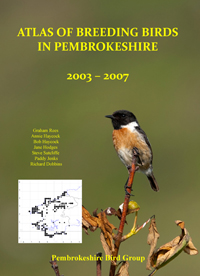Fulmar - 2003-07
 Monday, May 7, 2012 at 4:19PM
Monday, May 7, 2012 at 4:19PM Fulmars are now one of the commonest breeding seabirds around the coast of the UK but only a century ago were virtually unheard of as far south as Pembrokeshire. Their spectacular spread around the coast of the British Isles in the last century and a half is one of the best documented of any bird species. The Seabird 2000 survey estimated that there were just under 538,000 apparently occupied sites in Britain and Ireland.
In Pembrokeshire Fulmars can now be found virtually everywhere around the coastline. They nest on sheer cliff faces on small ledges in small groups and sometimes as individual pairs. Near Saundersfoot they nest behind the tangled roots of cliff edge trees, on the predator free islands sometimes on wide accessible ledges but always they try to find as much height as they can. Only where the cliffs are comprised of low sloping sandstone or are exposed fully to the glare of the sun are they absent. They are fairly easy to count as they occupy their sites for many months each year, and are only totally absent in September and October when they are at sea moulting.
The number of occupied sites increased steadily in the county from the first known breeding site at Flimston in 1940, to what seems to be a discernable peak of near to 2,500 sites in the mid to late 1990’s. Annual counts are very variable as many of the sites are occupied by non breeding or prospecting pairs.
Between the counts from 1985-88 and the Seabird 2000 counts, Fulmar numbers in the county jumped from 1,409 sites to almost exactly 2,500 sites. However these totals mask the changes from 1996, when detailed annual counts on Ramsey, Skomer, Skokholm, Castlemartin, St Margaret’s and Caldey, suggest that the trend in subsequent years has been at best stability and more probably the population is showing a tendency to a steady decline. The distribution maps also show a decline in tetrad occupancy
Steve Sutcliffe

Fieldwork 2003-07 (based on 490 tetrads)
Red = breeding confirmed = 61
Orange = breeding probable = 6
Yellow = breeding possible
Total tetrads in which registered = 67 (13.7%)
 PBBA 2003-7,
PBBA 2003-7,  SJS in
SJS in  Fulmar
Fulmar 

Reader Comments